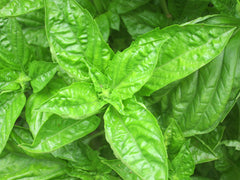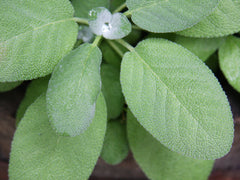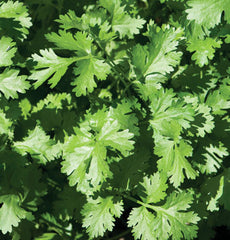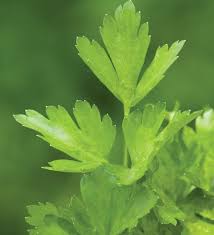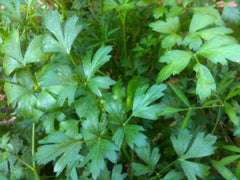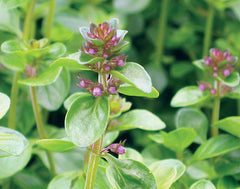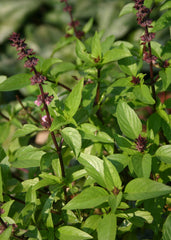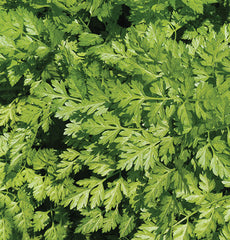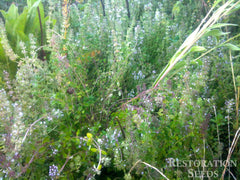Lettuce Leaf basil
HOW TO GROW BASIL
Start indoors 6 weeks before last frost, plant out 1 week after frost. In warmer climates, directly sow in a sunny location when soil temps are above 60-65˚F, tender annual. Requires bottom heat. If evening greenhouse air temperatures dip below 50˚F, domed clear covering may be needed to initiate germination, then remove covering. Pinch branch buds to encourage further branching, leaf production and prevent bolting. Dry herb bunches by hanging from ceiling or lay on screens in a dark, dry, ventilated location. Harvest for drying at peak maturity when flowers are just beginning to appear, leaves contain the most essential oils at that time, after that oils are transferred to flowers and then to seeds. Soil pH 5.1-8.5. Hardiness zones 7-11. Annual.
Days from maturity calculated from the date of seeding. Average 22,400 seeds per ounce. There are no Federal germination standards for commercially sold herb seeds. Usual seed life 3-5 years. Isolation distance for seed saving: 150 feet.
Planting Depth 1/4”
Soil Temp. Germ. 70-85˚F
Days to Germ. 7-14
Plant Spacing 12-18”
Row Spacing 18-24”
Days To Maturity 80
Full Sun, Moist Well Drained
Days from maturity calculated from the date of seeding. Average 22,400 seeds per ounce. There are no Federal germination standards for commercially sold herb seeds. Usual seed life 3-5 years. Isolation distance for seed saving: 150 feet.
Planting Depth 1/4”
Soil Temp. Germ. 70-85˚F
Days to Germ. 7-14
Plant Spacing 12-18”
Row Spacing 18-24”
Days To Maturity 80
Full Sun, Moist Well Drained
- 150 Seeds$4.10
- 1500 Seeds$15.50
Large 3-4” green crumpled leaf, classic basil, with edible flowers. Slightly sweeter than Genovese, less clove aroma. Best for the Pacific Northwest in our variety trials. Also known as Large Leafed Italian or Large Leaf Basil. Tags: Color: Green, Specialty: Deer Resistant, Season: Summer
There are many varie...
There are many varie...
Large 3-4” green crumpled leaf, classic basil, with edible flowers. Slightly sweeter than Genovese, less clove aroma. Best for the Pacific Northwest in our variety trials. Also known as Large Leafed Italian or Large Leaf Basil. Tags: Color: Green, Specialty: Deer Resistant, Season: Summer
There are many varieties of basil. The type used in Italian food is called sweet basil (Ocimum basilicum) as opposed to Thai basil (O. basilicum thyrsiflora), lemon basil (Ocimum citriodorum) and holy basil (Ocimum tenuiflorum) which are used in Asian cooking and medicine. Ocimum is derived from the Greek word meaning to smell, like other plants in the mint family with square stems. Basil oils have potent antioxidant, antiviral, and antimicrobial properties. Delicious basil recipes.
There are many varieties of basil. The type used in Italian food is called sweet basil (Ocimum basilicum) as opposed to Thai basil (O. basilicum thyrsiflora), lemon basil (Ocimum citriodorum) and holy basil (Ocimum tenuiflorum) which are used in Asian cooking and medicine. Ocimum is derived from the Greek word meaning to smell, like other plants in the mint family with square stems. Basil oils have potent antioxidant, antiviral, and antimicrobial properties. Delicious basil recipes.
Learn More
Meet Your Farmer
We promote fair trade, organic practices and environmental responsibility throughout the Restoration Seeds supply chain. Below are the family farmers and seed suppliers who bring our open pollinated seeds to you.
White Dog Farm
Conventional
Seed grower since 2019


White Dog Farm is nestled in the Williams Valley and is home to Greg & Kate Stanko. We are stewards of a 5 acre farm shared by sheep, chickens, pigs and Puja, our LGD. Our passion is to nurture the earth, grow flowers and vegetables sustainably using organic practices. Correspond to whitedogfarm57@gmail.com
Reviews
Customer Reviews
Based on 1 review
Write a review
